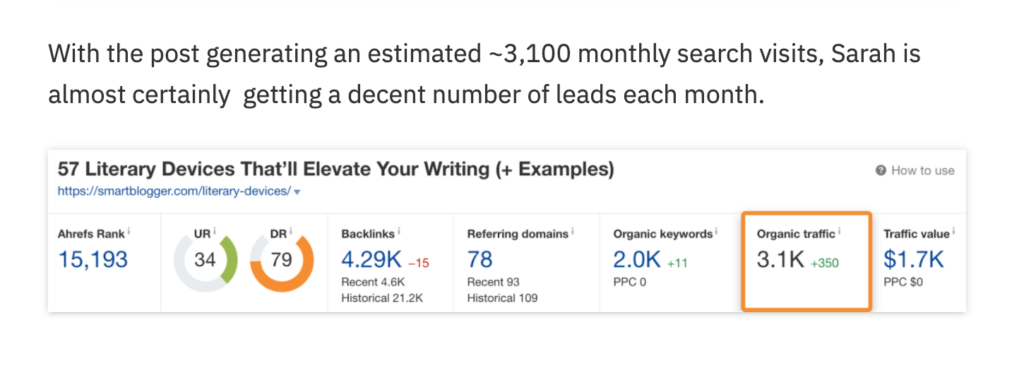Content marketers tend to avoid talking too directly about the product in their ‘top-of-funnel’ or awareness-building content.
We’re encouraged to ‘be the television show, not the ad.’ We write about customer’s pain points along with trends and opinions they might find interesting. We sprinkle our content with CTAs to learn more about the product should readers wish to.
But recently, that’s started to change. More brands are now putting their product at the heart of their content marketing as part of their Product-Led Growth strategy.
What is Product-Led Growth?
Product-Led Growth puts your product at the heart of your customer acquisition, activation and retention.
The thinking is that if you can get the user onto the product as quickly and easily as possible and show them how useful it is, they’ll sign up and start paying later.
It typically takes the form of a ‘freemium’ model or free trial where users can try the product without spending any money. Companies also offer discounts for referrals, or simply encourage users to share the product with others, creating network effects that drive further growth.
This may not sound revolutionary, but it works. In fact, the average value of companies following a Product-Led Growth strategy company is double the rest of the public SaaS index. Big names like Hubspot, Shopify, Airtable, Slack and Ahrefs all follow this model.
And more companies are now creating product-led content as an extension of this strategy.
What is product-led content?
To be honest, it’s kind of in the name. It’s content about your product. But there is a knack to doing it well, as we’ve written about before.
Product-led content isn’t a demo, a walkthrough or a feature announcement. It’s content that targets a specific pain point or problem that your audience has and shows how you solve it. It often also shows other solutions that don’t involve your product for the sake of balance.
Check out this post from ahref’s blog as an example. The title is ‘10 Lead Generation Tactics’ and there are a range of different ideas in there, some of which ahref’s tool can help out with. Where the tool can be used, they include screenshots so you can see the tool in action:

This content does two things. It gives the reader a bunch of lead generation tactics they might not have considered, which is useful in itself. But it also shows a whole load of relevant use cases for the product, with screenshots of the product in action so you can see how it works.
Here are a few other examples of product-led content from leading SaaS brands:
- Trello – Life Can Get Messy: How To Clean Up Your Digital Space
- Hotjar – Open-ended questions vs. close-ended questions: examples and how to survey users
- Airtable – How to build better alignment between your product and marketing teams
Why is product-led content so effective?
There are a few reasons why product-led content gets results.
It shows people how they could use the product
One of the challenges of SaaS marketing is making the value of the product feel tangible. Descriptions about benefits and features can leave the user unconvinced or unclear about how it will make their job easier.
Product-led content unpacks your use cases and shows people how your product works. Once a prospect understands how your product works, it’s much easier for them to imagine themselves using it.
It creates more qualified leads
If someone converts from a piece of product-led content it’s because they understand how your product can help them and want to try it for themselves. This is a much more valuable kind of intent than someone who downloads a report or ebook, who simply wants to know something or get something you’ve offered.
It perfectly tees up a free trial
If a user has clicked on an article about a specific pain point and seen how your product solves that problem, there’s a good chance they have that problem and understand how your product can help them. In other words, they are problem aware, solution aware and vendor aware.
That’s the perfect context for a conversion. This is why product-led content tends to have a much higher conversion rate than traditional top-of-funnel content.
Steal Our Playbook
We’ve spent years iterating and refining our proven growth playbook.
Now we’re giving it away for free.
Get it now
Do you need to be following a Product-Led Growth strategy to create product-led content?
No, you don’t.
Product-led content may have been popularised by companies that have committed to a Product-Led Growth strategy. But I think just about any SaaS company can make compelling product-led content.
If you identify genuine pain points and you’re able to solve those problems, then why not show people explicitly how you can do that for them?
That said, as we’ve mentioned already, it’s important that you strike the right balance between product-led content and a straight-up sales pitch. If you make your content too pushy, you’ll drive people away.
How can you create product-led content?
You should already know the core problems and pain points that your product solves – if you don’t, you can find some tips on identifying them through customer interviews here.
Pick one of your key pain points and write a detailed outline for a blog post following this basic structure.
1 – Establish the problem or pain point that your user has
Outline the pain point in language that your user will understand and identify with. Try to frame it from the user’s perspective, not your own.
For instance, Loom lets users quickly and easily record short video clips and screen shares. This is great, but the user might not be able to appreciate all the things this can help them do:
- Spend less time in meetings
- Write fewer emails
- Record product walkthroughs
- Conduct more effective cold outreach
Each of these can be reverse-engineered into a pain point they will identify with:
- Too many meetings
- Too many emails
- Lots of questions from users
- Cold emails being ignored
It might be tempting to try and wrap all of these pain points and use cases into one piece titled something like ‘X ways Loom can help you work faster and better’. Try to avoid this.
Instead, focus each piece of content on just one pain point. For instance, ‘How to half the number of hours your team spends in meetings’.
2 – Start by agitating the problem (ideally with some kind of proof)
Before getting into the solution, it’s worth agitating the problem a bit. You want to show your reader why this problem needs to be solved. Otherwise they might decide to live with it.
Statistics and storytelling can help with this. In any case, don’t just say that unnecessary meetings waste time. Say that the average employee attends 62 meetings a month, adding up to almost four working days a month, with more than half of those meetings being considered ‘a complete waste of time’.
Opening the piece in this way will make the reader see why they should keep reading.
3 – List potential solutions to this problem
Now you can list out a handful of solutions to the problem, including a few that your product can help out with. When you’re talking about the product, remember to show, not tell. Use images, screenshots, screen captures and step-by-step walkthroughs to show how your product works, how great it looks and how easy it is to use.
Once again, here are those examples that I shared earlier in the piece that will help you see how to get it right:
- Trello – Life Can Get Messy: How To Clean Up Your Digital Space
- Hotjar – Open-ended questions vs. close-ended questions: examples and how to survey users
- Airtable – How to build better alignment between your product and marketing teams
4 – Invite users to book a demo or free trial to learn more
Finally, sprinkle a few CTAs into your piece to book a demo or sign up for a free trial. Try to do it just after you’ve demonstrated the product’s value and tie the CTA back to the problem you’ve just solved. Relevancy is everything when it comes to CTAs.
For instance, let’s say you just showed how your platform can help people to spend less time in meetings by recording bitesize video clips.
You could say:
Want to replace your next one hour meeting with a 30-second video?
Sign up for a free trial today. You’ll be ready to start shooting your own videos in less than two minutes and you won’t have to spend a penny.
One of the great things about product-led content is that it’s actually really easy and cheap to make. If you have a product, a blog and a laptop you’re good to go.
As I’ve said a couple of times already, the best thing to do is to check out other brands that are doing it well and give it a shot.
If you have any questions or thoughts about product-led content, I’d love to hear them. You can drop me a line on LinkedIn
Thanks for reading.




